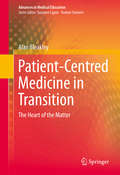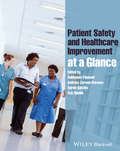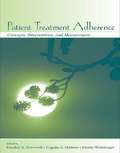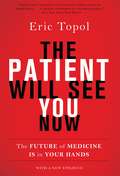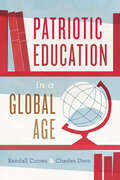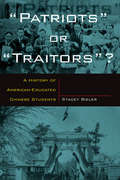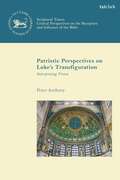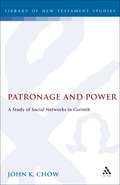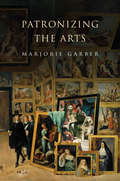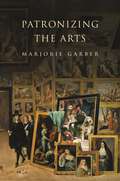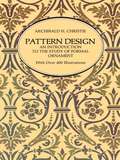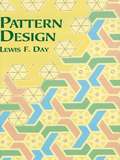- Table View
- List View
Patient-Centred Medicine in Transition: The Heart of the Matter (Advances in Medical Education #3)
by Alan BleakleyThis book challenges functional models for more aesthetic and ethical models, where communication is grounded in values systems of cultures. Here, communication is treated as a distributed phenomenon involving networks of persons, activities and artifacts, and extends beyond doctor-patient relationships to working in and across teams around patients. The purpose of the book is to stimulate thinking about how patient care and safety may be improved through a focus upon the ‘non-technical’ work of doctors – interpersonal communication, teamwork and situation awareness in teams. The focus is then not on the personality of the doctor, but on the dynamics of relationships which form doctors’ multiple identities.
Patient Safety and Healthcare Improvement at a Glance (At a Glance)
by Sukhmeet Panesar Andrew Carson-Stevens Sarah Salvilla Aziz SheikhPatient Safety and Healthcare Improvement at a Glance is a timely and thorough overview of healthcare quality written specifically for students and junior doctors and healthcare professionals. It bridges the gap between the practical and the theoretical to ensure the safety and wellbeing of patients. Featuring essential step-by-step guides to interpreting and managing risk, quality improvement within clinical specialties, and practice development, this highly visual textbook offers the best preparation for the increased emphasis on patient safety and quality-driven focus in today’s healthcare environment. Healthcare Improvement and Safety at a Glance: • Maps out and follows the World Health Organization Patient Safety curriculum • Draws upon the quality improvement work of the Institute for Healthcare Improvement This practical guide, covering a vital topic of increasing importance in healthcare, provides the first genuine introduction to patient safety and quality improvement grounded in clinical practice.
Patient Treatment Adherence: Concepts, Interventions, and Measurement
by Hayden B. Bosworth Eugene Z. Oddone Morris WeinbergerThis new book summarizes the adherence literature for a number of specific health behaviors and populations. It provides a comprehensive source on the conceptualization, interventions, and measurement of treatment adherence and a synthesis of the research across demographic and chronic diseases. The text presents problems associated with treatment adherence; theoretical models that have commonly been used to understand, predict, and/or improve adherence; adherence with specific behaviors including exercise, diet, rehabilitation, medication, and psychological therapies; and strategies in enhancing adherence.Because chronic diseases involve similar behaviors, the handbook is organized by specific behaviors and special populations, and not by disease. Every chapter is sub-organized by specific diseases to ensure easy access for the readers and features a discussion of adherence across demographic and chronic conditions, a review of previous interventions directed at the particular behavior or population, questions and scoring algorithms for widely used measures of treatment adherence, a discussion of the clinical research, and where appropriate, policy implications. Patient Treatment Adherence addresses: practical recommendations to improve adherence; the impact of non-adherence including costs and health-related quality of life; methodological issues such as assessing cost-effectiveness; and the use of technological advances to improve adherence.Intended for health service professionals, health, clinical, social, and cognitive psychologists, primary care physicians, pharmacists, and policy-makers, this text is also an excellent resource for graduate courses on health psychology and public health.
Patient Treatment Adherence: Concepts, Interventions, and Measurement
by Hayden B. Bosworth Eugene Z. Oddone Morris WeinbergerThis new book summarizes the adherence literature for a number of specific health behaviors and populations. It provides a comprehensive source on the conceptualization, interventions, and measurement of treatment adherence and a synthesis of the research across demographic and chronic diseases. The text presents problems associated with treatment adherence; theoretical models that have commonly been used to understand, predict, and/or improve adherence; adherence with specific behaviors including exercise, diet, rehabilitation, medication, and psychological therapies; and strategies in enhancing adherence.Because chronic diseases involve similar behaviors, the handbook is organized by specific behaviors and special populations, and not by disease. Every chapter is sub-organized by specific diseases to ensure easy access for the readers and features a discussion of adherence across demographic and chronic conditions, a review of previous interventions directed at the particular behavior or population, questions and scoring algorithms for widely used measures of treatment adherence, a discussion of the clinical research, and where appropriate, policy implications. Patient Treatment Adherence addresses: practical recommendations to improve adherence; the impact of non-adherence including costs and health-related quality of life; methodological issues such as assessing cost-effectiveness; and the use of technological advances to improve adherence.Intended for health service professionals, health, clinical, social, and cognitive psychologists, primary care physicians, pharmacists, and policy-makers, this text is also an excellent resource for graduate courses on health psychology and public health.
The Patient Will See You Now: The Future of Medicine Is in Your Hands
by Eric TopolThe essential guide by one of America's leading doctors to how digital technology enables all of us to take charge of our health A trip to the doctor is almost a guarantee of misery. You'll make an appointment months in advance. You'll probably wait for several hours until you hear "the doctor will see you now"-but only for fifteen minutes! Then you'll wait even longer for lab tests, the results of which you'll likely never see, unless they indicate further (and more invasive) tests, most of which will probably prove unnecessary (much like physicals themselves). And your bill will be astronomical.In The Patient Will See You Now, Eric Topol, one of the nation's top physicians, shows why medicine does not have to be that way. Instead, you could use your smartphone to get rapid test results from one drop of blood, monitor your vital signs both day and night, and use an artificially intelligent algorithm to receive a diagnosis without having to see a doctor, all at a small fraction of the cost imposed by our modern healthcare system.The change is powered by what Topol calls medicine's "Gutenberg moment." Much as the printing press took learning out of the hands of a priestly class, the mobile internet is doing the same for medicine, giving us unprecedented control over our healthcare. With smartphones in hand, we are no longer beholden to an impersonal and paternalistic system in which "doctor knows best." Medicine has been digitized, Topol argues; now it will be democratized. Computers will replace physicians for many diagnostic tasks, citizen science will give rise to citizen medicine, and enormous data sets will give us new means to attack conditions that have long been incurable. Massive, open, online medicine, where diagnostics are done by Facebook-like comparisons of medical profiles, will enable real-time, real-world research on massive populations. There's no doubt the path forward will be complicated: the medical establishment will resist these changes, and digitized medicine inevitably raises serious issues surrounding privacy. Nevertheless, the result-better, cheaper, and more human health care-will be worth it.Provocative and engrossing, The Patient Will See You Now is essential reading for anyone who thinks they deserve better health care. That is, for all of us.
The Patient Will See You Now: The Future of Medicine Is in Your Hands
by Eric TopolThe essential guide by one of America's leading doctors to how digital technology enables all of us to take charge of our health A trip to the doctor is almost a guarantee of misery. You'll make an appointment months in advance. You'll probably wait for several hours until you hear "the doctor will see you now"-but only for fifteen minutes! Then you'll wait even longer for lab tests, the results of which you'll likely never see, unless they indicate further (and more invasive) tests, most of which will probably prove unnecessary (much like physicals themselves). And your bill will be astronomical. In The Patient Will See You Now, Eric Topol, one of the nation's top physicians, shows why medicine does not have to be that way. Instead, you could use your smartphone to get rapid test results from one drop of blood, monitor your vital signs both day and night, and use an artificially intelligent algorithm to receive a diagnosis without having to see a doctor, all at a small fraction of the cost imposed by our modern healthcare system. The change is powered by what Topol calls medicine's "Gutenberg moment." Much as the printing press took learning out of the hands of a priestly class, the mobile internet is doing the same for medicine, giving us unprecedented control over our healthcare. With smartphones in hand, we are no longer beholden to an impersonal and paternalistic system in which "doctor knows best." Medicine has been digitized, Topol argues; now it will be democratized. Computers will replace physicians for many diagnostic tasks, citizen science will give rise to citizen medicine, and enormous data sets will give us new means to attack conditions that have long been incurable. Massive, open, online medicine, where diagnostics are done by Facebook-like comparisons of medical profiles, will enable real-time, real-world research on massive populations. There's no doubt the path forward will be complicated: the medical establishment will resist these changes, and digitized medicine inevitably raises serious issues surrounding privacy. Nevertheless, the result-better, cheaper, and more human health care-will be worth it. Provocative and engrossing, The Patient Will See You Now is essential reading for anyone who thinks they deserve better health care. That is, for all of us.
Patrick Heron
by Andrew Wilson Sara MatsonPublished to accompany the first major Patrick Heron retrospective in two decades, this book will feature the best of Heron’s paintings, from the 1940s to his late career, alongside thought-provoking text.
Patriotic Education in a Global Age (History and Philosophy of Education Series)
by Randall Curren Charles DornShould schools attempt to cultivate patriotism? If so, why? And what conception of patriotism should drive those efforts? Is patriotism essential to preserving national unity, sustaining vigorous commitment to just institutions, or motivating national service? Are the hazards of patriotism so great as to overshadow its potential benefits? Is there a genuinely virtuous form of patriotism that societies and schools should strive to cultivate? In Patriotic Education in a Global Age, philosopher Randall Curren and historian Charles Dorn address these questions as they seek to understand what role patriotism might legitimately play in schools as an aspect of civic education. They trace the aims and rationales that have guided the inculcation of patriotism in American schools over the years, the methods by which schools have sought to cultivate patriotism, and the conceptions of patriotism at work in those aims, rationales, and methods. They then examine what those conceptions mean for justice, education, and human flourishing. Though the history of attempts to cultivate patriotism in schools offers both positive and cautionary lessons, Curren and Dorn ultimately argue that a civic education organized around three components of civic virtue—intelligence, friendship, and competence—and an inclusive and enabling school community can contribute to the development of a virtuous form of patriotism that is compatible with equal citizenship, reasoned dissent, global justice, and devotion to the health of democratic institutions and the natural environment. Patriotic Education in a Global Age mounts a spirited defense of democratic institutions as it situates an understanding of patriotism in the context of nationalist, populist, and authoritarian movements in the United States and Europe, and will be of interest to anyone concerned about polarization in public life and the future of democracy.
Patriotic Education in a Global Age (History and Philosophy of Education Series)
by Randall Curren Charles DornShould schools attempt to cultivate patriotism? If so, why? And what conception of patriotism should drive those efforts? Is patriotism essential to preserving national unity, sustaining vigorous commitment to just institutions, or motivating national service? Are the hazards of patriotism so great as to overshadow its potential benefits? Is there a genuinely virtuous form of patriotism that societies and schools should strive to cultivate? In Patriotic Education in a Global Age, philosopher Randall Curren and historian Charles Dorn address these questions as they seek to understand what role patriotism might legitimately play in schools as an aspect of civic education. They trace the aims and rationales that have guided the inculcation of patriotism in American schools over the years, the methods by which schools have sought to cultivate patriotism, and the conceptions of patriotism at work in those aims, rationales, and methods. They then examine what those conceptions mean for justice, education, and human flourishing. Though the history of attempts to cultivate patriotism in schools offers both positive and cautionary lessons, Curren and Dorn ultimately argue that a civic education organized around three components of civic virtue—intelligence, friendship, and competence—and an inclusive and enabling school community can contribute to the development of a virtuous form of patriotism that is compatible with equal citizenship, reasoned dissent, global justice, and devotion to the health of democratic institutions and the natural environment. Patriotic Education in a Global Age mounts a spirited defense of democratic institutions as it situates an understanding of patriotism in the context of nationalist, populist, and authoritarian movements in the United States and Europe, and will be of interest to anyone concerned about polarization in public life and the future of democracy.
Patriotic Education in a Global Age (History and Philosophy of Education Series)
by Randall Curren Charles DornShould schools attempt to cultivate patriotism? If so, why? And what conception of patriotism should drive those efforts? Is patriotism essential to preserving national unity, sustaining vigorous commitment to just institutions, or motivating national service? Are the hazards of patriotism so great as to overshadow its potential benefits? Is there a genuinely virtuous form of patriotism that societies and schools should strive to cultivate? In Patriotic Education in a Global Age, philosopher Randall Curren and historian Charles Dorn address these questions as they seek to understand what role patriotism might legitimately play in schools as an aspect of civic education. They trace the aims and rationales that have guided the inculcation of patriotism in American schools over the years, the methods by which schools have sought to cultivate patriotism, and the conceptions of patriotism at work in those aims, rationales, and methods. They then examine what those conceptions mean for justice, education, and human flourishing. Though the history of attempts to cultivate patriotism in schools offers both positive and cautionary lessons, Curren and Dorn ultimately argue that a civic education organized around three components of civic virtue—intelligence, friendship, and competence—and an inclusive and enabling school community can contribute to the development of a virtuous form of patriotism that is compatible with equal citizenship, reasoned dissent, global justice, and devotion to the health of democratic institutions and the natural environment. Patriotic Education in a Global Age mounts a spirited defense of democratic institutions as it situates an understanding of patriotism in the context of nationalist, populist, and authoritarian movements in the United States and Europe, and will be of interest to anyone concerned about polarization in public life and the future of democracy.
Patriotic Education in a Global Age (History and Philosophy of Education Series)
by Randall Curren Charles DornShould schools attempt to cultivate patriotism? If so, why? And what conception of patriotism should drive those efforts? Is patriotism essential to preserving national unity, sustaining vigorous commitment to just institutions, or motivating national service? Are the hazards of patriotism so great as to overshadow its potential benefits? Is there a genuinely virtuous form of patriotism that societies and schools should strive to cultivate? In Patriotic Education in a Global Age, philosopher Randall Curren and historian Charles Dorn address these questions as they seek to understand what role patriotism might legitimately play in schools as an aspect of civic education. They trace the aims and rationales that have guided the inculcation of patriotism in American schools over the years, the methods by which schools have sought to cultivate patriotism, and the conceptions of patriotism at work in those aims, rationales, and methods. They then examine what those conceptions mean for justice, education, and human flourishing. Though the history of attempts to cultivate patriotism in schools offers both positive and cautionary lessons, Curren and Dorn ultimately argue that a civic education organized around three components of civic virtue—intelligence, friendship, and competence—and an inclusive and enabling school community can contribute to the development of a virtuous form of patriotism that is compatible with equal citizenship, reasoned dissent, global justice, and devotion to the health of democratic institutions and the natural environment. Patriotic Education in a Global Age mounts a spirited defense of democratic institutions as it situates an understanding of patriotism in the context of nationalist, populist, and authoritarian movements in the United States and Europe, and will be of interest to anyone concerned about polarization in public life and the future of democracy.
Patriotic Education in a Global Age (History and Philosophy of Education Series)
by Randall Curren Charles DornShould schools attempt to cultivate patriotism? If so, why? And what conception of patriotism should drive those efforts? Is patriotism essential to preserving national unity, sustaining vigorous commitment to just institutions, or motivating national service? Are the hazards of patriotism so great as to overshadow its potential benefits? Is there a genuinely virtuous form of patriotism that societies and schools should strive to cultivate? In Patriotic Education in a Global Age, philosopher Randall Curren and historian Charles Dorn address these questions as they seek to understand what role patriotism might legitimately play in schools as an aspect of civic education. They trace the aims and rationales that have guided the inculcation of patriotism in American schools over the years, the methods by which schools have sought to cultivate patriotism, and the conceptions of patriotism at work in those aims, rationales, and methods. They then examine what those conceptions mean for justice, education, and human flourishing. Though the history of attempts to cultivate patriotism in schools offers both positive and cautionary lessons, Curren and Dorn ultimately argue that a civic education organized around three components of civic virtue—intelligence, friendship, and competence—and an inclusive and enabling school community can contribute to the development of a virtuous form of patriotism that is compatible with equal citizenship, reasoned dissent, global justice, and devotion to the health of democratic institutions and the natural environment. Patriotic Education in a Global Age mounts a spirited defense of democratic institutions as it situates an understanding of patriotism in the context of nationalist, populist, and authoritarian movements in the United States and Europe, and will be of interest to anyone concerned about polarization in public life and the future of democracy.
Patriotic Education in a Global Age (History and Philosophy of Education Series)
by Randall Curren Charles DornShould schools attempt to cultivate patriotism? If so, why? And what conception of patriotism should drive those efforts? Is patriotism essential to preserving national unity, sustaining vigorous commitment to just institutions, or motivating national service? Are the hazards of patriotism so great as to overshadow its potential benefits? Is there a genuinely virtuous form of patriotism that societies and schools should strive to cultivate? In Patriotic Education in a Global Age, philosopher Randall Curren and historian Charles Dorn address these questions as they seek to understand what role patriotism might legitimately play in schools as an aspect of civic education. They trace the aims and rationales that have guided the inculcation of patriotism in American schools over the years, the methods by which schools have sought to cultivate patriotism, and the conceptions of patriotism at work in those aims, rationales, and methods. They then examine what those conceptions mean for justice, education, and human flourishing. Though the history of attempts to cultivate patriotism in schools offers both positive and cautionary lessons, Curren and Dorn ultimately argue that a civic education organized around three components of civic virtue—intelligence, friendship, and competence—and an inclusive and enabling school community can contribute to the development of a virtuous form of patriotism that is compatible with equal citizenship, reasoned dissent, global justice, and devotion to the health of democratic institutions and the natural environment. Patriotic Education in a Global Age mounts a spirited defense of democratic institutions as it situates an understanding of patriotism in the context of nationalist, populist, and authoritarian movements in the United States and Europe, and will be of interest to anyone concerned about polarization in public life and the future of democracy.
Patriots or Traitors: A History of American Educated Chinese Students
by Stacey BielerThis title sxplores the love-hate relationship between the USA and China through the experience of Chinese students caught between the two countries. The book sheds light on China's ambivelance towards the Western influence, and the use of educational and cultural exhanges as a political device.
Patriots or Traitors: A History of American Educated Chinese Students
by Stacey BielerThis title sxplores the love-hate relationship between the USA and China through the experience of Chinese students caught between the two countries. The book sheds light on China's ambivelance towards the Western influence, and the use of educational and cultural exhanges as a political device.
Patristic Perspectives on Luke’s Transfiguration: Interpreting Vision (The Library of New Testament Studies)
by Peter AnthonyPeter Anthony explores how visionary elements in Luke's Gospel had a particular influence on early interpretation of the Transfiguration, by examining the rich hermeneutical traditions that emerged - particularly in the Latin West - as the Transfiguration was first depicted visually in art.Anthony begins by comparing the visual and visionary culture of antiquity with that of the present, and their differing interpretations of the Transfiguration. He then examines the Transfiguration texts in the synoptic gospels and their interpretation in modern scholarship, and the reception of the Transfiguration in 2 Peter, the Apocalypse of Peter and the Acts of Peter, Tertullian and Origen. Proceeding to look at interpretations found in the Greek East and the Latin West, Anthony finally discusses the earliest visual depictions of the Transfiguration from the sixth century onward, drawn from a wealth of different art forms. Anthony concludes that early commentators' and artists' understanding of how we see and visualise, and therefore, how the Transfiguration was apprehended, is closer to that of the writers of the New Testament than many modern interpreters' is.
Patristic Perspectives on Luke’s Transfiguration: Interpreting Vision (The Library of New Testament Studies)
by Peter AnthonyPeter Anthony explores how visionary elements in Luke's Gospel had a particular influence on early interpretation of the Transfiguration, by examining the rich hermeneutical traditions that emerged - particularly in the Latin West - as the Transfiguration was first depicted visually in art.Anthony begins by comparing the visual and visionary culture of antiquity with that of the present, and their differing interpretations of the Transfiguration. He then examines the Transfiguration texts in the synoptic gospels and their interpretation in modern scholarship, and the reception of the Transfiguration in 2 Peter, the Apocalypse of Peter and the Acts of Peter, Tertullian and Origen. Proceeding to look at interpretations found in the Greek East and the Latin West, Anthony finally discusses the earliest visual depictions of the Transfiguration from the sixth century onward, drawn from a wealth of different art forms. Anthony concludes that early commentators' and artists' understanding of how we see and visualise, and therefore, how the Transfiguration was apprehended, is closer to that of the writers of the New Testament than many modern interpreters' is.
Patronage and Power: A Study of Social Networks in Corinth (The Library of New Testament Studies #75)
by John K. ChowFrom 1 Corinthians we know that the church at Corinth was beset by all sorts of problems. Some of these problems resulted from contacts with the pagan world - one member of the church cohabited with his stepmother, one brought a suit against another brother before the pagan magistrate, some ate idolatrous feasts at the pagan temple, and others underwent baptism for the dead. This refreshing and stimulating book seeks to understand the significance of these problems from the perspective of the social structures and conditions of this Graeco-Roman city, and places Paul's response to them in the same context.
Patronizing the Arts
by Marjorie GarberWhat is the role of the arts in American culture? Is art an essential element? If so, how should we support it? Today, as in the past, artists need the funding, approval, and friendship of patrons whether they are individuals, corporations, governments, or nonprofit foundations. But as Patronizing the Arts shows, these relationships can be problematic, leaving artists "patronized"--both supported with funds and personal interest, while being condescended to for vocations misperceived as play rather than serious work. In this provocative book, Marjorie Garber looks at the history of patronage, explains how patronage has elevated and damaged the arts in modern culture, and argues for the university as a serious patron of the arts. With clarity and wit, Garber supports rethinking prejudices that oppose art's role in higher education, rejects assumptions of inequality between the sciences and humanities, and points to similarities between the making of fine art and the making of good science. She examines issues of artistic and monetary value, and transactions between high and popular culture. She even asks how college sports could provide a new way of thinking about arts funding. Using vivid anecdotes and telling details, Garber calls passionately for an increased attention to the arts, not just through government and private support, but as a core aspect of higher education. Compulsively readable, Patronizing the Arts challenges all who value the survival of artistic creation both in the present and future.
Patronizing the Arts
by Marjorie GarberWhat is the role of the arts in American culture? Is art an essential element? If so, how should we support it? Today, as in the past, artists need the funding, approval, and friendship of patrons whether they are individuals, corporations, governments, or nonprofit foundations. But as Patronizing the Arts shows, these relationships can be problematic, leaving artists "patronized"--both supported with funds and personal interest, while being condescended to for vocations misperceived as play rather than serious work. In this provocative book, Marjorie Garber looks at the history of patronage, explains how patronage has elevated and damaged the arts in modern culture, and argues for the university as a serious patron of the arts. With clarity and wit, Garber supports rethinking prejudices that oppose art's role in higher education, rejects assumptions of inequality between the sciences and humanities, and points to similarities between the making of fine art and the making of good science. She examines issues of artistic and monetary value, and transactions between high and popular culture. She even asks how college sports could provide a new way of thinking about arts funding. Using vivid anecdotes and telling details, Garber calls passionately for an increased attention to the arts, not just through government and private support, but as a core aspect of higher education. Compulsively readable, Patronizing the Arts challenges all who value the survival of artistic creation both in the present and future.
Patronizing the Arts
by Marjorie GarberWhat is the role of the arts in American culture? Is art an essential element? If so, how should we support it? Today, as in the past, artists need the funding, approval, and friendship of patrons whether they are individuals, corporations, governments, or nonprofit foundations. But as Patronizing the Arts shows, these relationships can be problematic, leaving artists "patronized"--both supported with funds and personal interest, while being condescended to for vocations misperceived as play rather than serious work. In this provocative book, Marjorie Garber looks at the history of patronage, explains how patronage has elevated and damaged the arts in modern culture, and argues for the university as a serious patron of the arts. With clarity and wit, Garber supports rethinking prejudices that oppose art's role in higher education, rejects assumptions of inequality between the sciences and humanities, and points to similarities between the making of fine art and the making of good science. She examines issues of artistic and monetary value, and transactions between high and popular culture. She even asks how college sports could provide a new way of thinking about arts funding. Using vivid anecdotes and telling details, Garber calls passionately for an increased attention to the arts, not just through government and private support, but as a core aspect of higher education. Compulsively readable, Patronizing the Arts challenges all who value the survival of artistic creation both in the present and future.
Patronizing the Arts
by Marjorie GarberWhat is the role of the arts in American culture? Is art an essential element? If so, how should we support it? Today, as in the past, artists need the funding, approval, and friendship of patrons whether they are individuals, corporations, governments, or nonprofit foundations. But as Patronizing the Arts shows, these relationships can be problematic, leaving artists "patronized"--both supported with funds and personal interest, while being condescended to for vocations misperceived as play rather than serious work. In this provocative book, Marjorie Garber looks at the history of patronage, explains how patronage has elevated and damaged the arts in modern culture, and argues for the university as a serious patron of the arts. With clarity and wit, Garber supports rethinking prejudices that oppose art's role in higher education, rejects assumptions of inequality between the sciences and humanities, and points to similarities between the making of fine art and the making of good science. She examines issues of artistic and monetary value, and transactions between high and popular culture. She even asks how college sports could provide a new way of thinking about arts funding. Using vivid anecdotes and telling details, Garber calls passionately for an increased attention to the arts, not just through government and private support, but as a core aspect of higher education. Compulsively readable, Patronizing the Arts challenges all who value the survival of artistic creation both in the present and future.
Pattakhor: पत्ताखोर
by Madhu Kankariyaस्वातंत्र्योत्तर भारतीय समाज में हमने जहाँ विकास और प्रगति की कई मंजिले तय की हैं वहीं अनेक व्याधियाँ भी अर्जित की हैं। अनेक समाजार्थिक कारणों से हम ऐसी कुछ बीमारियों से घिरे हैं। जिनका कोई सिरा पकड़ में नहीं आता।
Pattern Design: An Introduction to the Study of Formal Ornament
by Archibald H. ChristieApproaching the study of design from a structural point of view, this classic handbook tells the designer how to construct hundreds of patterns from all periods and styles. Dr. Christie analyzes the elemental composition of patterns, and shows how coherent organization is achieved in each of the patterns he describes and illustrates. He then establishes basic principles, derived from the unity of all great ornament, which, if followed, will assure the success of any design.In the opening chapters the author describes various basic methods of organizing ornament, and explains the formal classification of ornament into distinct categories. He covers the six major categories of design separately, showing how numerous variations are made: traditional plant and animal devices; realistic plants and animals; straight striped patterns; waved and chevron striped patterns; cross-band patterns; and interlaced and counterchanged cross-band patterns. In another chapter he shows how some isolated devices of formal design -- granular texturings, disk and ring devices, arabesques, and more -- are constructed. He shows how design is created by rhythmic expansion -- how an element like a spiral or a swastika, for example, can be expanded in horizontal, vertical, and diagonal progressions to create the rhythmic scheme that constitutes a formal design.The book contains more than 400 illustrations, including the author's drawing of designs as well as photographs of actual patterns in textiles, ceramics, jewelry, and more -- a wealth of valuable pictorial material that is not readily available. As a unified discussion of the nature of patterns, this book will be of great interest to anyone concerned with handicrafts or the fine arts.
Pattern Design
by Lewis F. DayTake any form you choose and repeat it at regular intervals, and, just as repetitive sounds produce rhythm or cadence, you have pattern. However, the use of pattern in design is no haphazard matter, but a disciplined activity in which the artists must impose a pleasing order and structure on the whole to achieve an aesthetically satisfying end product.This classic guide, revised and expanded by Amor Fenn three decades after its publication, teaches artists to do just that. Surveying a multitude of applications, from architectural detail to decorative textile printing and typographic patterns, Day provides insight into the geometric foundations of all repeating patterns, and treats in a practical way the anatomy, planning, and evolution of repeated ornament. He demonstrates the extent to which pattern is the essence of the ornamental arts, and offers a wealth of technical information for the student and designer.Generously illustrated with more than 270 designs ranging from old Japanese, Persian, and Arabian patterns to early 20th-century motifs, Pattern Design will stimulate the imaginations and advance the skills of novices and experts alike.
